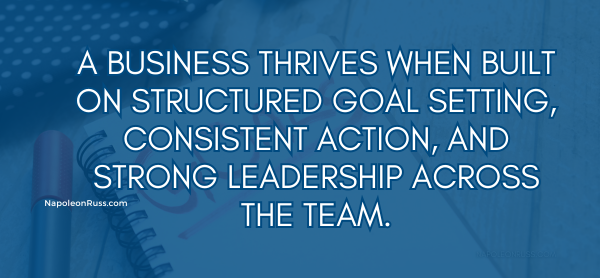Success in business requires more than enthusiasm and hard work—it demands a structured system of goal setting, disciplined execution, and continuous improvement. In this guide, we outline proven strategies to set powerful business goals and achieve them with clarity and confidence.
Why Goal Setting is Critical in Business
In business, growth and profitability are directly tied to performance. Without clearly defined goals, it becomes easy to lose focus or waste energy on unproductive tasks. Goals provide:
- Direction: A clear path to follow.
- Motivation: A reason to stay consistent despite setbacks.
- Measurement: A way to track progress and adjust.
Successful business leaders always operate with specific, measurable, and time-bound goals.
Step 1: Define Your Business Vision and Purpose
Before setting goals, identify your larger purpose. Ask yourself:
- Why did you choose this business path?
- What lifestyle changes are you aiming for?
- How will reaching your goals impact your family, team, and community?
Write down a vision statement that reflects your ultimate destination. This statement will serve as a compass whenever challenges arise.
Step 2: Use SMART Goals for Business Success
The SMART framework ensures your goals are actionable and realistic.
- Specific: “Increase sales by 20% this quarter” instead of “Grow revenue.”
- Measurable: Define numbers for sales volume, clients acquired, or income.
- Achievable: Align goals with your available time and resources.
- Relevant: Focus on actions that directly move your business forward.
- Time-bound: Set deadlines for accountability.
Step 3: Break Down Long-Term Goals into Milestones
Big goals without milestones often feel overwhelming. Create a roadmap that connects long-term objectives to smaller, achievable tasks.
Step 4: Build a Daily Action Plan
In business, consistency wins. Design a daily action plan around:
- Prospecting: Reach out to new potential clients or partners.
- Follow-ups: Contact prospects who showed initial interest.
- Team Support: Train, guide, or motivate employees or collaborators.
- Personal Growth: Read, attend workshops, or invest in skill development.
Your daily plan should directly connect to your long-term objectives.
Step 5: Track and Measure Progress
Without tracking, you cannot improve. Use tools such as:
- CRM or business management software
- Spreadsheets for sales, marketing, or operations
- Performance dashboards
Set aside weekly time to review results, identify bottlenecks, and refine strategies.
Step 6: Develop Leadership Within Your Team
Your growth depends on building strong leaders around you. Focus on:
- Training new team members with clear onboarding.
- Hosting regular meetings or check-ins.
- Recognizing achievements to keep morale high.
- Encouraging leadership and accountability at every level.
A strong, self-sustaining team ensures long-term stability and scalability.
Step 7: Stay Accountable and Motivated
Running a business can feel isolating without support. Build accountability by:
- Partnering with a mentor or accountability partner.
- Joining mastermind groups or networking communities.
- Publicly sharing your goals with your team.
Celebrate small wins to maintain momentum and motivation.
Step 8: Overcome Common Business Goal-Setting Mistakes
Avoid these pitfalls:
- Setting vague goals: Without clarity, action becomes scattered.
- Ignoring timelines: Delayed action weakens results.
- Overcommitting: Unrealistic goals lead to burnout.
- Neglecting personal development: Skills and mindset fuel long-term growth.
Step 9: Align Goals with Business Incentives
Most industries offer opportunities for recognition, bonuses, or growth benchmarks. Align your goals with these incentives to maximize progress while earning rewards along the way.
Step 10: Revisit and Adjust Goals Regularly
The business landscape evolves—your goals must evolve too. Review them quarterly and ask:
- Are these goals still aligned with my vision?
- Do I need to increase targets based on performance?
- What strategies worked best, and which failed?
Continuous adjustment ensures you stay ahead.
Conclusion: Building a Goal-Oriented Business
A business thrives when built on structured goal setting, consistent action, and strong leadership across the team. By defining your vision, applying SMART goals, breaking them into actionable steps, and continuously tracking results, you create a system that guarantees steady progress.
Commit to your plan, lead by example, and watch your business goals transform into measurable success.

💫 You were never given a dream without also being given the power to make it come true.
If you’re ready to believe in yourself and start creating the freedom you deserve —
✨ Get instant access to my Free Affiliate Marketing Course and learn the simple steps to build income online, even if you’re starting from zero.









